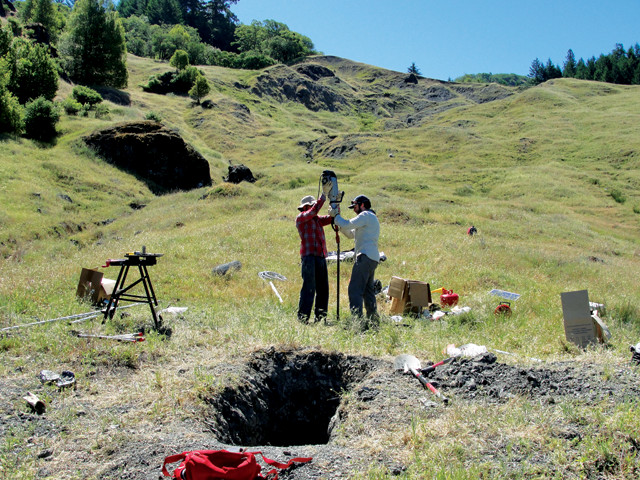
by Jane Palmer Tuesday, May 1, 2018

Researchers study the Two Towers Landslide in Northern California, which moves about a meter a year and is representative of thousands of clay-rich landslides worldwide. Credit: William Schulz.
Rainfall can trigger landslides, and it can also cause slow-moving slides to speed up. But researchers have observed that rain also appears to cause landslides composed of clay-rich material to take longer to start moving, and to move slower than expected.
To investigate why, William Schulz of the U.S. Geological Survey (USGS) Landslide Hazards Program in Golden, Colo., and his colleagues studied the Two Towers Landslide in Northern California, which is representative of thousands of earthflows worldwide: a mixture of clay, silt and rock fragments that moves slowly and persistently. Two Towers measures approximately 250 meters in length and averages 40 meters wide and 7 meters deep. The side boundaries of the slide are nearly vertical and on average, it moves less than 1 meter per year.
The researchers measured rainfall at Two Towers between November 2014 and July 2017 to understand water inputs at the site. They also noted groundwater pressure at the landslide’s head, middle and toe; movement; the amount of soil swelling; and horizontal stresses on the side-bounding faults. In the lab, the researchers tested the strength, composition and inherent swell-pressure — how much pressure the material will exert after absorbing water.
The lab analysis revealed that much of the landslide is composed of smectites — a group of highly expandable clay minerals — which, when infiltrated by water, can create very high swell-pressures. In the field, the researchers observed this same swelling resulting in high pressures along the landslide’s side-bounding faults.
Usually, during the rainy season, water seeps into the main body of a landslide and increases the water pressure in pore spaces, which reduces friction until it becomes weak enough for the mass to slide. But during and following the rainy season between October and April at Two Towers, sliding for each of the three years of observation was delayed by about six to seven months compared to what was expected, based on established studies relating water pressure and landslide earth movement. The researchers’ new study, published in Geophysical Research Letters, suggests that clay’s swelling potential might explain the delay at Two Towers.
The scientists hypothesize that expanding clay pushes outward on the faults that bound the sides of the landslide, acting as a brake by increasing resistance. With continuing rainfall, however, increased water pressure in the pores reduces frictional resistance enough to overcome the resistance exerted by the swelling clay, which allows the landslide to accelerate.
And even when there isn’t enough rain in a given wet season to surpass the threshold, when the soil in the landslide eventually dries out a few months later, it contracts and the horizontal pressure decreases, releasing the brakes and allowing the landslide to move.
“The important implication is that the models that we have been hanging our hat on for so many years are incomplete,” says co-author Joshua Roering, a geoscientist at the University of Oregon. “To assess the stability of a landslide, you really need to adopt a three-dimensional perspective [of the slide].”
When the researchers created a mathematical model of the landslide, which incorporated the swelling pressure along with recorded groundwater pressures and measured strengths of the slide material, they found it correctly predicted the delayed initiation of the landslide and its reduced speed. The model estimated that the swelling added nearly 9 percent to the total resistance to landslide motion.
“It is a new and novel mechanism, which will apply elsewhere,” says Dave Petley, a natural hazards specialist at the University of Sheffield in England, who was not involved in the research. “[This work] explains the behavior of some landslides, but not all.”
To fully test their theory, the researchers would have to conduct similar investigations on slides composed of less expandable material and with different geometries, Schulz says. “Soil swelling may partly determine timing and speed of many landslides,” he says. “If this theory holds up, it really should change the way we try to forecast [the] timing and mobility [of clay landslides].”
© 2008-2021. All rights reserved. Any copying, redistribution or retransmission of any of the contents of this service without the expressed written permission of the American Geosciences Institute is expressly prohibited. Click here for all copyright requests.